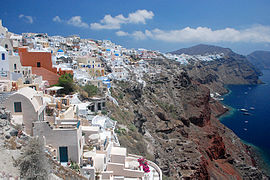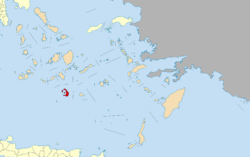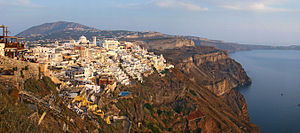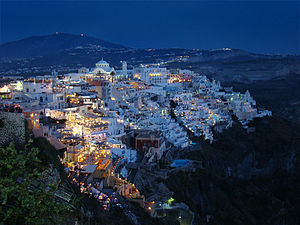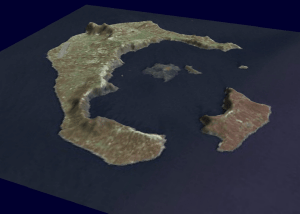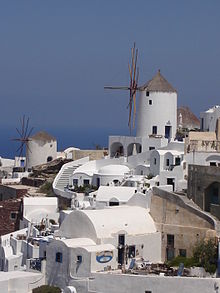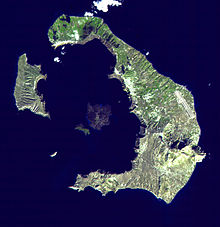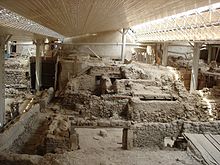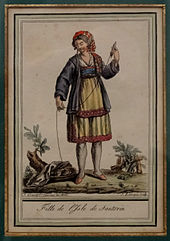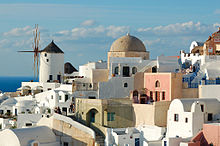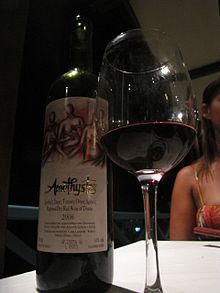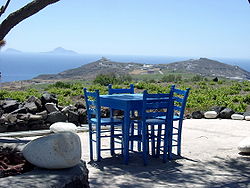
Santorini
Background to the schools Wikipedia
SOS Children made this Wikipedia selection alongside other schools resources. A quick link for child sponsorship is http://www.sponsor-a-child.org.uk/
Santorini (Greek: Σαντορίνη, pronounced [sadoˈrini]), classically Thera (pron.: / ˈ θ ɪ r ə /), and officially Thira (Greek: Θήρα [ˈθira]), is an island in the southern Aegean Sea, about 200 km (120 mi) southeast from Greece's mainland. It is the largest island of a small, circular archipelago which bears the same name and is the remnant of a volcanic caldera. It forms the southernmost member of the Cyclades group of islands, with an area of approximately 73 km2 (28 sq mi) and a 2011 census population of 15,550. The municipality of Santorini comprises the inhabited islands of Santorini and Therasia and the uninhabited islands of Nea Kameni, Palaia Kameni, Aspronisi, and Christiana. The total land area is 90.623 km2 (34.990 sq mi). Santorini is part of the Thira regional unit.
Santorini is essentially what remains after an enormous volcanic explosion that destroyed the earliest settlements on a formerly single island, and created the current geological caldera. A giant central, rectangular lagoon, which measures about 12 by 7 km (7.5 by 4.3 mi), is surrounded by 300 m (980 ft) high, steep cliffs on three sides. The main island slopes downward to the Aegean Sea. On the fourth side, the lagoon is separated from the sea by another much smaller island called Therasia; the lagoon is connected to the sea in two places, in the northwest and southwest. The caldera being 400m deep makes it possible for all but the largest ships to anchor anywhere in the protected bay; there is also a newly built marina in Vlychada on the southwestern coast. The principal port is called Athinias. The capital, Fira, clings to the top of the cliff looking down on the lagoon. The volcanic rocks present from the prior eruptions feature olivine and have a small presence of hornblende.
It is the most active volcanic centre in the South Aegean Volcanic Arc, though what remains today is chiefly a water-filled caldera. The volcanic arc is approximately 500 km (310 mi) long and 20 to 40 km (12 to 25 mi) wide. The region first became volcanically active around 3–4 million years ago, though volcanism on Thera began around 2 million years ago with the extrusion of dacitic lavas from vents around the Akrotiri.
The island is the site of one of the largest volcanic eruptions in recorded history: the Minoan eruption (sometimes called the Thera eruption), which occurred some 3600 years ago at the height of the Minoan civilization. The eruption left a large caldera surrounded by volcanic ash deposits hundreds of metres deep and may have led indirectly to the collapse of the Minoan civilization on the island of Crete, 110 km (68 mi) to the south, through a gigantic tsunami. Another popular theory holds that the Thera eruption is the source of the legend of Atlantis.
Names
Santorini was named by the Latin Empire in the thirteenth century, and is a reference to Saint Irene, from the name of the old cathedral in the village of Perissa. Before then, it was known as Kallístē (Καλλίστη, "the most beautiful one"), Strongýlē (Greek: Στρογγύλη, "the circular one"), or Thēra. The name Thera was revived in the nineteenth century as the official name of the island and its main city, but the colloquial name Santorini is still in popular use. During the Ottoman Empire's domination of the Aegean Sea, the Turkish exonym for the island was "Santurin" or "Santoron".
Municipality
The present municipality of Thera (officially: "Thira", Greek: Δήμος Θήρας), which covers all settlements on the islands of Santorini and Therasia, was formed at the 2011 local government reform, by the merger of the former Oia and Thera municipalities.
Oia is now called a Κοινότητα (commune), within the municipality of Thera, and it comprises the local subdivisions (Greek: τοπικό διαμέρισμα) of Therasia and Oia.
The municipality of Thera includes an additional 12 local subdivisions on Santorini island: Akrotiri, Emporio, Episkopis Gonia, Exo Gonia, Imerovigli, Karterados, Megalohori, Mesaria, Pyrgos Kallistis, Thera (the seat of the municipality), Vothon, and Vourvoulos.
Geologic setting
The Cyclades are part of a metamorphic complex that is known as the Cycladic Massif. The complex formed during the Miocene and was folded and metamorphosed during the Alpine Orogeny around 60 million years ago. Thera is built upon a small, non-volcanic basement that represents the former non-volcanic island, which was approximately 9 by 6 km (5.6 by 3.7 mi). The basement rock primarily comprises metamorphosed limestone and schist, which date from the Alpine Orogeny. These non-volcanic rocks are exposed at the Profitis Ilias Mountains, Mesa Vouno, the Gavrillos ridge, Pyrgos, Monolithos, and the inner side of the caldera wall between Cape Plaka and Athinios.
The metamorphic grade comprises a blueschist facies, which results from tectonic deformation by the subduction of the African Plate beneath the Eurasian Plate. Subduction occurred between the Oligocene and the Miocene, and the metamorphic grade represents the southernmost extent of the Cycladic blueschist belt.
Volcanism on Santorini is due to the Hellenic Trench subduction zone southwest of Crete. The oceanic crust of the northern margin of the African Plate is being subducted under Greece and the Aegean Sea. which comprises thinned continental crust. The subduction compels the formation of the Hellenic arc, which includes Santorini and other volcanic centres, such as Methana, Milos, and Kos.
Geography
The island is the result of repeated sequences of shield volcano construction followed by caldera collapse. The inner coast around the caldera is a sheer precipice of more than 300 m drop at its highest, and exhibits the various layers of solidified lava on top of each other, and the main towns perched on the crest. The ground then slopes outwards and downwards towards the outer perimeter, and the outer beaches are smooth and shallow. Beach sand colour depends on which geologic layer is exposed; there are beaches with sand or pebbles made of solidified lava of various colours: the Red Beach, the Black Beach, the White Beach, etc. The water at the darker coloured beaches is significantly warmer because the lava acts as a heat absorber.
Climate
Santorini and Anafi are the only locations in Europe to feature a hot desert climate according to the Köppen climate classification system.
History
Minoan Akrotiri
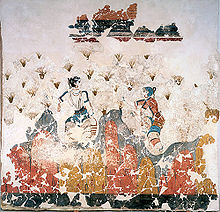
Excavations starting in 1967 at the site called Akrotiri under the late Professor Spyridon Marinatos have made Thera the best-known Minoan site outside of Crete, the homeland of the culture. The island was not known as Thera at this time. Only the southern tip of a large town has been uncovered, yet it has revealed complexes of multi-level buildings, streets, and squares with remains of walls standing as high as eight metres, all entombed in the solidified ash of the famous eruption of Thera. The site was not a palace-complex such as are found in Crete, but its excellent masonry and fine wall-paintings show that this was certainly no conglomeration of merchants' warehousing either. A loom-workshop suggests organized textile weaving for export. This Bronze Age civilization thrived between 3000 to 2000 BC, and reached its peak in the period 2000 to 1580 BC.
Some of the houses in Akrotiri are major structures, some amongst them three storeys high. Its streets, squares, and walls were preserved in the layers of ejecta, sometimes as tall as eight metres, and indicating this was a major town. In many houses stone staircases are still intact, and they contain huge ceramic storage jars ( pithoi), mills, and pottery. Noted archaeological remains found in Akrotiri are wall paintings or frescoes, which have kept their original colour well, as they were preserved under many metres of volcanic ash. The town also had a highly developed drainage system and, judging from the fine artwork, its citizens were clearly sophisticated and relatively wealthy people.
Pipes with running water and water closets found at Akrotiri are the oldest such utilities discovered. The pipes run in twin systems, indicating that the Therans used both hot and cold water supplies; the origin of the hot water probably was geothermic, given the volcano's proximity. The dual pipe system, the advanced architecture, and the apparent layout of the Akrotiri find resemble Plato's description of the legendary lost city of Atlantis, further indicating the Minoans as the culture which primarily inspired the Atlantis legend.
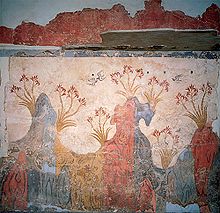
Fragmentary wall-paintings at Akrotiri lack the insistent religious or mythological content familiar in Classical Greek décor. Instead, the Minoan frescoes depict "Saffron-Gatherers", who offer their crocus-stamens to a seated lady, perhaps a goddess. Crocus has been discovered to have many medicinal values including the relief of menstrual pain. This has led many archaeologists to believe that the fresco of the saffron/crocus gatherers is a coming of age fresco dealing with female pubescence. In another house are two antelopes, painted with a kind of confident, flowing, decorative, calligraphic line, the famous fresco of a fisherman with his double strings of fish strung by their gills, and the flotilla of pleasure boats, accompanied by leaping dolphins, where ladies take their ease in the shade of light canopies, among other frescoes.
The well preserved ruins of the ancient town often are compared to the spectacular ruins at Pompeii in Italy. The canopy covering the ruins collapsed in an accident in September 2005, killing one tourist and injuring seven more. The site was closed for almost seven years while a new canopy was built. The site was re-opened in April 2012.
The oldest signs of human settlement are Late Neolithic ( 4th millennium BC or earlier), but ca. 2000–1650 BC Akrotiri developed into one of the Aegean's major Bronze Age ports, with recovered objects that had come, not just from Crete, but also from Anatolia, Cyprus, Syria, and Egypt as well as from the Dodecanese and the Greek mainland.
Dating of the Bronze Age eruption
The Minoan eruption provides a fixed point for the chronology of the second millennium BC in the Aegean, because evidence of the eruption occurs throughout the region and the site itself contains material culture from outside. The eruption occurred during the "Late Minoan IA" period at Crete and the "Late Cycladic I" period in the surrounding islands.
Archaeological evidence, based on the established chronology of Bronze Age Mediterranean cultures dates the eruption to around 1500 BC. These dates, however, conflict with radiocarbon dating which indicates that the eruption occurred about 1645–1600 BC. Around the time of the radiocarbon-indicated date of the eruption, there is evidence for a significant climatic event in the Northern Hemisphere. The evidence includes failure of crops in China, as well as evidence from tree rings. The tree rings date the climatic event to 1628 BC.
Ancient and medieval Santorini
Santorini remained unoccupied throughout the rest of the Bronze Age, during which time the Greeks took over Crete. At Knossos, in a LMIIIA context (14th century BC), seven Linear B texts while calling upon "all the gods" make sure to grant primacy to an elsewhere-unattested entity called qe-ra-si-ja and, once, qe-ra-si-jo. If the endings -ia[s] and -ios represent an ethnikonic suffix, then this means "The One From Qeras[os]". If aspirated, *Qhera- would have become "Thera-" in later Greek. "Therasia" and its ethnikon "Therasios" are both attested in later Greek; and, since -sos was itself a genitive suffix in the Aegean Sprachbund, *Qeras[os] could also shrink to *Qera. An alternate view takes qe-ra-si-ja and qe-ra-si-jo as proof of androgyny, and applies this name by similar arguments to the legendary seer, Tiresias, but these views are not mutually exclusive of one another. If qe-ra-si-ja was an ethnikon first, then in following him/her/it the Cretans also feared whence it came.
Over the centuries after the general catastrophes of 1200 BC, Phoenicians founded a site on Thera. Herodotus reports that the Phoenicians called the island Callista and lived on it for eight generations. Then, in the 9th century BC, Dorians founded the main Hellenic city - on Mesa Vouno, 396 m above sea level. This group later claimed that they had named the city and the island after their leader, Theras. Today, that city is referred to as Ancient Thera.
Apollonius Rhodius' Argonautica, written in Hellenistic Egypt in the 3rd century BC, includes an origin and sovereignty myth of Thera being given by Triton in Libya to the Greek Argonaut Euphemus, son of Poseidon, in the form of a clod of dirt. After carrying the dirt next to his heart for several days, Euphemus dreamt that he nursed the dirt with milk from his breast, and that the dirt turned into a beautiful woman with whom he had sex. The woman then told him that she was a daughter of Triton named Kalliste, and that when he threw the dirt into the sea it would grow into an island for his descendants to live on. The poem goes on to claim that the island was named Thera after Euphemus' descendant Theras, son of Autesion, the leader of a group of refugee settlers from Lemnos.
The Dorians have left a number of inscriptions incised in stone, in the vicinity of the temple of Apollo, attesting to pederastic relations between the authors and their eromenoi. These inscriptions, found by Friedrich Hiller von Gaertringen, have been thought by some archaeologists to be of a ritual, celebratory nature, due to their large size, careful construction and - in some cases - execution by craftsmen other than the authors.
According to Herodotus (4.149-165), following a drought of seven years, Thera sent out colonists who founded a number of cities in northern Africa, including Cyrene.
In the 5th century BC, Dorian Thera did not join the Delian League with Athens; and during the Peloponnesian War, Thera sided with Dorian Sparta, against Athens. The Athenians took the island during the war, but lost it again after the Battle of Aegospotami.
During the Hellenistic period, the island was a major naval base for the Ptolemaic Egypt.
As with other Greek territories, Thera then was ruled by the Romans; it passed to the eastern side of the Empire when it divided - which now is known as the Byzantine Empire. According to George Cedrenus, the volcano erupted in the summer of 727, the tenth year of the reign of Leo III the Isaurian. He writes: "In the same year, in the summer, a vapour like an oven's fire boiled up for days out of the middle of the islands of Thera and Therasia from the depths of the sea, and the whole place burned like fire, little by little thickening and turning to stone, and the air seemed to be a fiery torch."
During the Crusades, the " Franks" (Catholic Western Europeans) settled it, while in the 13th century AD, the Venetians annexed the isle to the Duchy of Naxos and renamed it "Santorini", that is " Saint Irene". Santorini came under Ottoman rule in 1579.
Santorini in the Greek State
Santorini became independent from Ottoman rule in 1821, during the Greek War of Independence and was united with Greece in 1830 under the Treaty of London.
Modern Santorini
In 1956 a major earthquake near Amorgos island resulted in the demolishing of many buildings in the north of Santorini, leading to the desertion of many of its villages.
The expansion of tourism has resulted in the growth of the economy and population. The major settlements include Fira (Phira), Oia, Emporio, Kamari, Perissa, Imerovigli, Pyrgos, and Therasia. Akrotiri is a major archaeological site, with ruins from the Minoan era. Santorini's primary industry is tourism, particularly in the summer months. In 2007, the cruise ship MS Sea Diamond ran aground and sank inside the caldera. The island's pumice quarries have been closed since 1986, in order to preserve the caldera. Santorini was ranked world's top island for 2011 in Travel+Leisure Magazine. Santorini was also named "the world's best island" by the BBC in 2011.
Aridity
Santorini has no rivers, and water is scarce. Until the early 1990s locals filled water cisterns from the rain that fell on roofs and courts, from small springs, and with imported assistance from other areas of Greece. In recent years a desalination plant has provided running, yet non-potable, water to most houses. Since rain is rare on the island from mid-spring till mid-autumn, many plants depend on the scant moisture provided by the common, early morning fog condensing on the ground as dew.
Wine industry
The island remains the home of a small, but flourishing, wine industry, based on the indigenous grape variety, Assyrtiko, with auxiliary cultivations of two other Aegean varietals, Athiri and Aidani. The vines are extremely old and resistant to phylloxera (attributed by local winemakers to the well-drained volcanic soil and its chemistry), so the vines needed no replacement during the great phylloxera epidemic of the late 19th century. In their adaptation to their habitat, such vines are planted far apart, as their principal source of moisture is dew, and they often are trained in the shape of low-spiralling baskets, with the grapes hanging inside to protect them from the winds.
The viticultural pride of the island is the sweet and strong Vinsanto (Italian: "holy wine"), a dessert wine made from the best sun-dried Assyrtiko, Athiri, and Aidani grapes and undergoing long barrel aging (up to twenty or twenty-five years for the top cuvées). It matures to a sweet, dark amber-orange, unctuous dessert wine that has achieved worldwide fame, possessing the standard Assyrtiko aromas of citrus and minerals, layered with overtones of nuts, raisins, figs, honey and tea.
White wines from the island are extremely dry with a strong, citrus scent and mineral and iodide salt aromas contributed by the ashy volcanic soil, whereas barrel aging gives to some of the white wines a slight frankincense aroma, much like Vinsanto. It is not easy to be a winegrower in Santorini; the hot and dry conditions give the soil a very low productivity. The yield per acre is only 10 to 20% of the yields that are common in France or California. The island's wines are standardised and protected by the "Vinsanto" and "Santorini" OPAP designations of origin.
Agriculture
Due to its unique ecology and climate, and especially its volcanic ash soil, Santorini is home to unique and prized produce. Santorini tomatoes are renowned; they are cherry tomatoes that are extremely tasty and sweet, and with an intensely red, staining colour. Santorini "fava" is a purée made of the hulled, then sun-dried, then boiled legume Lathyrus sativus - not from the yellow split pea as in the rest of Greece. The white eggplants of Santorini are very sweet, with very few seeds, and can be eaten raw. The katsoúni is a unique local variety of large cucumber which, if left unpicked when green, turn yellow and acquire a sweet taste almost indistinguishable from that of melon.
Architecture
The traditional architecture of Santorini is similar to that of the other Cyclades, with low-lying cubical houses, made of local stone and whitewashed or limewashed with various volcanic ashes used as colours. The unique characteristic is the common utilisation of the hypóskapha: extensions of houses dug sideways or downwards into the surrounding pumice. These rooms are prized because of the high insulation provided by the air-filled pumice, and are used as living quarters of unique coolness in the summer and warmth in the winter, and also as premium storage space for produce and especially for wine cellaring: the Kánava wineries of Santorini.
Airport
Santorini is one of the few Cyclades Islands with a major airport , which lies about 6 km southeast of downtown Thera. The main asphalt runway (16L-34R) is 2,125 metres (6,972 feet) in length, and the parallel taxiway was built to runway specification (16R-34L). It can accommodate Boeing 757, Boeing 737, Airbus 320 series, Avro RJ, Fokker 70, and ATR 72 aircraft. Scheduled airlines include the new Olympic Air, Aegean Airlines and Athens Airways, with chartered flights from other airlines during the summer, and transportation to and from the air terminal is through buses, taxis, hotel car-pickups and rental cars.
Volcanic eruptions
Recent volcanism
In 1707 an undersea volcano breached the sea surface, forming the current centre of activity at Nea Kameni in the centre of the lagoon, and eruptions centred on it continue — the twentieth century saw three such, the last in 1950. Santorini was also struck by a devastating earthquake in 1956. Although the volcano is quiescent at the present time, at the current active crater (there are several former craters on Nea Kameni), steam and carbon dioxide are given off.
Santorini has erupted many times, with varying degrees of explosivity. There have been at least twelve large explosive eruptions, of which at least four were caldera-forming. The most famous eruption is the Minoan eruption, detailed below. Eruptive products range from basalt all the way to rhyolite, and the rhyolitic products are associated with the most explosive eruptions.
The earliest eruptions, many of which were submarine, were on the Akrotiri Peninsula, and active between 650,000 and 550,000 years ago. These are geochemically distinct from the later volcanism, as they contain amphiboles.
Over the past 360,000 years there have been two major cycles, each culminating with two caldera-forming eruptions. The cycles end when the magma evolves to a rhyolitic composition, causing the most explosive eruptions. In between the caldera-forming eruptions are a series of sub-cycles. Lava flows and small explosive eruptions build up cones, which are thought to impede the flow of magma to the surface. This allows the formation of large magma chambers, in which the magma can evolve to more silicic compositions. Once this happens, a large explosive eruption destroys the cone. The Kameni islands in the centre of the lagoon are the most recent example of a cone built by this volcano, with much of them hidden beneath the water.
Minoan eruption
Physical eruption
The devastating volcanic eruption of Thera has become the most famous single event in the Aegean before the fall of Troy. It may have been one of the largest volcanic eruptions on Earth in the last few thousand years, with an estimated 7 on the VEI ( volcanic explosivity index). The violent eruption was centred on a small island just north of the existing island of Nea Kameni in the centre of the caldera; the caldera itself was formed several hundred thousand years ago by the collapse of the centre of a circular island, caused by the emptying of the magma chamber during an eruption. It has been filled several times by ignimbrite since then, and the process repeated itself, most recently 21,000 years ago. The northern part of the caldera was refilled by the volcano, then collapsing once more during the Minoan eruption. Before the Minoan eruption, the caldera formed a nearly continuous ring with the only entrance between the tiny island of Aspronisi and Thera; the eruption destroyed the sections of the ring between Aspronisi and Therasia, and between Therasia and Thera, creating two new channels.
On Santorini, a deposit of white tephra thrown from the eruption is found lying up to 60 m (200 ft) thick, overlying the soil marking the ground level before the eruption, and forming a layer divided into three fairly distinct bands indicating different phases of the eruption. New archaeological discoveries by a team of international scientists, in 2006, have revealed that the Santorini event was much more massive than previously thought; it expelled 61 cubic kilometres (15 cu mi) of magma and rock into the Earth's atmosphere, compared to previous estimates of only 39 cubic kilometres (9.4 cu mi) in 1991, producing an estimated 100 cubic kilometres (24 cu mi) of tephra. Only the Mount Tambora volcanic eruption of 1815, the 181 AD eruption of Lake Taupo, and possibly Baekdu Mountain's 969 AD eruption released more material into the atmosphere during the past 5,000 years.
Speculation on an Exodus connection
In The Parting of the Sea: How Volcanoes, Earthquakes, and Plagues Shaped the Exodus Story, geologist Barbara J. Sivertsen seeks to establish a link between the eruption of Santorini ca. 1628 BC and the Exodus from Egypt in the Bible.
A 2006 documentary film by Simcha Jacobovici, The Exodus Decoded, postulates that the eruption of the Santorini Island volcano (c. 1500 BC, +/-50) caused all the biblical plagues described against Egypt ; this date also corresponds to the Biblical dating of Moses in Egypt c. 1500 BC +/-50. The film asserts that the Hyksos were the Israelites and that some of them may have originally been from Mycenae. The film also asserts that these original Mycenaean Israelites fled Egypt (which they had in fact ruled for some time) after the eruption, back to Mycenae. The pharaoh with whom they identify the Pharaoh of the Exodus is Ahmose I. Rather than crossing the Red Sea, Jacobovici argued a marshy area in northern Egypt known as the " Reed Sea" would have been alternately drained and flooded by tsunamis caused by the caldera collapse, and could have been crossed during the Exodus.
Jacobovici's assertions in The Exodus Decoded have been extensively criticized by religious scholars.
In a 2013 book on this connection, Thera and the Exodus, Riaan Booysen presents additional support for this theory through a comprehensive study of ancient Greek legends of floods in the Mediterranean Sea and Egyptian records attesting to floods in their country, as well as the interpretation of legendary names associated with various Egyptian kings (pharaohs) of that period. He identifies the pharaoh of the Exodus as Amenhotep III and the biblical Moses as Crown Prince Tuthmosis, Amenhotep’s first-born son and heir to his throne.
Speculation on an Atlantis connection
Archaeological, seismological, and vulcanological evidence has been presented linking the Atlantis myth to Santorini. Speculation suggesting that Thera/Santorini was the inspiration for Plato's Atlantis began with the excavation of Akrotiri in the 1960s, and gained increased currency as reconstructions of the island's pre-eruption shape and landscape frescos located under the ash both strongly resembled Plato's description. The possibility has been more recently popularized by television documentaries such as: The History Channel programme Lost Worlds (episode "Atlantis"), the Discovery Channel's Solving History with Olly Steeds, and the BBC's Atlantis, The Evidence that suggests that Thera is Plato's Atlantis.
Recent eruptions
Post-Minoan eruptive activity is concentrated on the Kameni islands, in the centre of the lagoon. They have been formed since the Minoan eruption, and the first of them broke the surface of the sea in 197 BC Nine subaerial eruptions are recorded in the historical record since that time, with the most recent ending in 1950. Since then the volcano has been quiescent.
Small tremors and reports of strange gaseous odours over the course of 2011 and 2012 prompted satellite radar technological analyses and these revealed the source of the symptoms; the magma chamber under the volcano was swelled by a rush of molten rock by 10 to 20 million cubic metres between January 2011 and April 2012 which also caused parts of the island’s surface to rise out of the water by a reported 8 to 14 centimetres. Scientists say that the injection of molten rock was equivalent to 20 years’ worth of regular activity.
